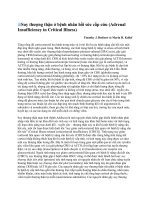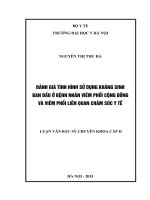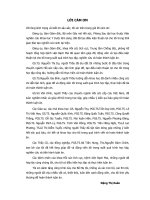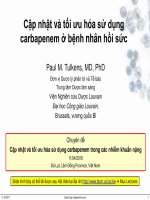PD kháng sinh ứng dụng ở bệnh nhân hồi sức: betalactam và vancomycin
Bạn đang xem bản rút gọn của tài liệu. Xem và tải ngay bản đầy đủ của tài liệu tại đây (2.41 MB, 69 trang )
<span class='text_page_counter'>(1)</span><div class='page_container' data-page=1>
<b>Update on PK/PD of antibiotics applied to </b>
<b>critically ill patients:</b>
<b>Focus on β-lactams and vancomycin</b>
Paul M. Tulkens, MD, PhD
Cellular and Molecular Pharmacology
Center for Clinical Pharmacy
Louvain Drug Research Institute
<i>Université catholique de Louvain, </i>
Brussels, Belgium
<b>18</b>
<b>th</b>
<b><sub>Vietnam Association of Critical Care Medicine, Emergency and Clinical Toxicology</sub></b>
Annual Congress – 12-13 March 2018
Đà Lạt, Lâm Đồng Province, Việt Nam
</div>
<span class='text_page_counter'>(2)</span><div class='page_container' data-page=2>
<b>A quick reminder of drug pharmacodynamics…</b>
ln EC
<sub>50 </sub>- 2
<b>E</b>
<b><sub>max</sub></b>
<b>Maximal effect</b>
<b>E</b>
<b><sub>min</sub></b>
<b>Minimal effect</b>
<b>concentration</b>
</div>
<span class='text_page_counter'>(3)</span><div class='page_container' data-page=3>
<b>In chemotherapy, aim for a maximal effect !</b>
ln EC
<sub>50 </sub>- 2
<b>E</b>
<b><sub>max</sub></b>
<b>Maximal effect</b>
<b>concentration</b>
<b>This is what you </b>
<b>should aim for in </b>
</div>
<span class='text_page_counter'>(4)</span><div class='page_container' data-page=4>
<b>Pharmacodynamics of antibiotics… </b>
<b>-2</b>
<b>-1</b>
<b>0</b>
<b>1</b>
<b>2</b>
<b>-4</b>
<b>-2</b>
<b>0</b>
<b>2</b>
<b>-2</b>
<b>-1</b>
<b>0</b>
<b>1</b>
<b>2</b>
<b>-4</b>
<b>-2</b>
<b>0</b>
<b>2</b>
<b>log extracellular</b>
<b>concentration (X MIC)</b>
<b> l</b>
<b>o</b>
<b>g</b>
<b> CF</b>
<b>U/</b>
<b>m</b>
<b>g</b>
<b> p</b>
<b>ro</b>
<b>t.</b>
<b> fro</b>
<b>m</b>
<b> ti</b>
<b>m</b>
<b>e</b>
<b> 0</b>
<b>oxacillin</b>
<b>gentamicin</b>
E
<sub>min</sub>
E
<sub>max</sub>
E
<sub>min</sub>
E
<sub>max</sub>
<i><b>S. </b></i>
<i><b>aureus</b></i>
<b>It looks as if </b>
<b>they are all </b>
<b>concentration</b>
<b>-dependent…</b>
</div>
<span class='text_page_counter'>(5)</span><div class='page_container' data-page=5>
<b>But here comes pharmacokinetics …</b>
<b>C</b>
<b><sub>min</sub></b>
<b>–C</b>
<b><sub>max</sub></b>
<b>-2</b>
<b>-1</b>
<b>0</b>
<b>1</b>
<b>2</b>
<b>-4</b>
<b>-2</b>
<b>0</b>
<b>2</b>
<b>-2</b>
<b>-1</b>
<b>0</b>
<b>1</b>
<b>2</b>
<b>-4</b>
<b>-2</b>
<b>0</b>
<b>2</b>
<b>log extracellular</b>
<b>concentration (X MIC)</b>
<b> l</b>
<b>o</b>
<b>g</b>
<b> CF</b>
<b>U/</b>
<b>m</b>
<b>g</b>
<b> p</b>
<b>ro</b>
<b>t.</b>
<b> fro</b>
<b>m</b>
<b> ti</b>
<b>m</b>
<b>e</b>
<b> 0</b>
<b>oxacillin</b>
<b>gentamicin</b>
<b>Weak </b>
<b>concentration-dependence (max. effect</b>
<b>over the C</b>
<b><sub>min</sub></b>
<b>–C</b>
<b><sub>max</sub></b>
<b>range) </b>
<b> TIME will emerge as the </b>
<b>main parameter in vivo</b>
<b>high </b>
<b>concentration-dependence </b>
<b>over the C</b>
<b><sub>min</sub></b>
<b>-C</b>
<b><sub>max</sub></b>
<b>range</b>
<b> the time is less </b>
<b>important than the actual </b>
<b>concentration</b>
<i>S.</i>
<i> aureus</i>
</div>
<span class='text_page_counter'>(6)</span><div class='page_container' data-page=6>
<b>PK parameters governing the activity of antibiotics</b>
0
6
<sub>12</sub>
18
<sub>24</sub>
Concentration
<b>MIC</b>
Time (h)
<i><b>f T > MIC</b></i>
<i><b>f T > MIC</b></i>
<b>AUC</b>
<b><sub>24h</sub></b>
<b>/ MIC</b>
<b>C</b>
<b><sub>max</sub></b>
<b>/ MIC</b>
</div>
<span class='text_page_counter'>(7)</span><div class='page_container' data-page=7>
The three main groups of antibiotics
<b>Class</b>
<b>Driving PK/PD parameter</b>
<b>Symbol</b>
<b>What to do ?</b>
β-lactams
• time during which the free*
concentration is > MIC
<i>fT></i>
<b>MIC</b>
• frequent
administrations
• extended/continu
ous infusion
aminoglycosides
and
fluoroquinolones
• free* concentration > MIC
bactericidal rate
• free* AUC/MIC ratio
global effect
<i>fC</i>
<b><sub>max</sub></b>
/MIC
<i>fAUC</i>
<b><sub>24h</sub></b>
/MIC
• get a peak !
• total daily dose
most other
antibiotics
• free* AUC/MIC
<i>fAUC</i>
<b><sub>24h</sub></b>
/MIC
• total daily dose
• schedule accord.
to half-life
• continuous
</div>
<span class='text_page_counter'>(8)</span><div class='page_container' data-page=8>
Animal models: what can you measure…
Andes & Craig WA Int J Antimicrob Agents 2002;19:261–268
</div>
<span class='text_page_counter'>(9)</span><div class='page_container' data-page=9>
Beta-lactams …in a nutshell…
• Every antibiotic is
concentration-depedendent
(simple pharmacological principle) …
<b>• BUT, for </b>
-lactams, activity if already
optimal when the concentration
exceeds the MIC by 3 to 4-fold, which
is what easily happens with
conventional administration… and
bacteria with low MICs
<b>• AND, having no post-antibiotic effect, </b>
-lactams need to stay above the MIC
(preferably 4-fold…) for the maximum
time…
</div>
<span class='text_page_counter'>(10)</span><div class='page_container' data-page=10>
PK/PD questions about
-lactams:
PK/PD aspects
</div>
<span class='text_page_counter'>(11)</span><div class='page_container' data-page=11>
<b>How long above the MIC for a typical β-lactam ? </b>
<b>100 % </b>
<b>40 %</b>
<b>Mild and </b>
<b>non-life-threatening infections</b>
<b>Serious, </b>
<b>life-threatening infections</b>
<b>• cefotaxime</b>
</div>
<span class='text_page_counter'>(12)</span><div class='page_container' data-page=12>
<b>Typical pharmacokinetics of an IV </b>
<b>-lactam</b>
time
serum concentration for
(hours)
0.5 g
1 g
2 g
2
25
50
100
4
12.5
25
50
6
6
12
25
8
3
6
12
10
1.5
3
6
12
0.75
1.5
3
</div>
<span class='text_page_counter'>(13)</span><div class='page_container' data-page=13>
<b>Simple optimisation of IV </b>
<b>-lactams</b>
<b>for "difficult" organisms</b>
• 2 g every 12 h
<b>T > MIC = 100 % </b>
<b>if MIC </b>
<b>3 mg/L !</b>
• 2 g every 8 h
<b>T > MIC = 100 % </b>
<b>if MIC </b>
<b>12 mg/L</b>
More frequent administrations is the best way to increase the activity of
-lactams in difficult-to-treat infections..
.
<b>PK / PD breakpoint for </b>
</div>
<span class='text_page_counter'>(14)</span><div class='page_container' data-page=14>
<b>Where do you wish to be ?</b>
time
serum concentration for
(hours)
0.5 g
1 g
2 g
2
25
50
100
4
12.5
25
50
6
6
12
25
8
3
6
12
10
1.5
3
6
12
0.75
1.5
3
* Single administration; half-life 2h ; V
<sub>d</sub>
= 0.2 l/kg
<b>this is </b>
<b>what </b>
</div>
<span class='text_page_counter'>(15)</span><div class='page_container' data-page=15>
But again, how much above MIC ?
<b>4 X MIC</b>
</div>
<span class='text_page_counter'>(16)</span><div class='page_container' data-page=16>
How much ?
</div>
<span class='text_page_counter'>(17)</span><div class='page_container' data-page=17>
<b>But do not forget about changes in MIC </b>
<b>(low-level resistance) during treatment !</b>
<b>meropenem (n=28)</b>
<b>D0</b> <b>DL</b>
<b>0.125</b>
<b>0.25</b>
<b>0.5</b>
<b>1</b>
<b>2</b>
<b>4</b>
<b>8</b>
<b>16</b>
<b>32</b>
<b>64</b>
<b>128</b>
<b>256</b>
<b>*</b>
<b>piperacillin-tazobactam (n=31)</b>
<b>D0</b> <b>DL</b>
<b>2</b>
<b>4</b>
<b>8</b>
<b>16</b>
<b>32</b>
<b>64</b>
<b>128</b>
<b>256</b>
<b>512</b>
<b>1024</b>
<b>*</b>
<b>M</b>
<b>IC </b>
<b>(m</b>
<b>g</b>
<b>/L</b>
<b>)</b>
Change in MIC of antibiotics used in empiric antipseudomonal therapy (nosocomial pneumonia; intensive care units)
<i>towards the isolate identified before onset of therapy (D0) vs. the last isolate (DL) collected from the same patient and </i>
with clonal similarity with the first isolate. Differences were analyzed using both raw and log
<b><sub>2</sub></b>transformed data and
found significant by both non-parametric (Wilcoxon matched pair test) and parametric (two-tailed paired t-test)
analysis.
</div>
<span class='text_page_counter'>(18)</span><div class='page_container' data-page=18>
<b>More optimization to prevent emergence of resistance</b>
<i>Tam et al. J Antimicrob Chemother 2017;72:1421-1428 - PMID: </i>28158470
</div>
<span class='text_page_counter'>(19)</span><div class='page_container' data-page=19>
Tam et al. J Antimicrob Chemother 2017;72:1421-1428 - PMID: 28158470
<b>More optimization to prevent emergence of resistance</b>
<b>placebo</b>
<b>ceftazidime</b>
<b>0.5 g</b>
<b>q8h</b>
<b>ceftazidime</b>
<b>3 g</b>
<b>g q8h</b>
<b>To prevent emergence of resistance, C</b>
<b><sub>min</sub></b><b>of </b>
<b>β-lactams must stay > 4 x MIC (mean), which commands </b>
<b>higher dosages…</b>
</div>
<span class='text_page_counter'>(20)</span><div class='page_container' data-page=20>
Some discussion about β
•
<i><b>f T > MIC is the driving parameter, but what </b></i>
<b>is needed may vary between 40 to 100 %</b>
depending upon the severity of the
infection…
providing a 100 % coverage may be
particularly useful in servere infections
(ICU, …) or
-lactams, activity if already
optimal when the concentration exceeds
the MIC by 3 to 4-fold, which is what easily
happens with conventional
administration… and bacteria with low
MICs
•
<b>4 x the MIC provides optimal efficacy and </b>
prevention of resistance…
This is what you may like to aim at in
severe, difficult-to-treat infections, but
lower values may be effective (not lower
than 1 x the MIC, however…
<b>OK !</b>
<b>May be…</b>
</div>
<span class='text_page_counter'>(21)</span><div class='page_container' data-page=21>
There is growing evidence that standard
antibiotic regimens may not provide adequate
drug concentrations in ICU patients …
</div>
<span class='text_page_counter'>(22)</span><div class='page_container' data-page=22>
A. Abdulla et al: University Medical Center Rotterdam; eposter 069; ECCMID 2017
Hosthoff et al, Swiss Med Wkly. 2016;146:w14368
Roberts JA, Lipman J. Clin Pharmacokinetic 2006; 45 (8): 755-73
RRT: renal replacement therapy
ECMO: extra corporeal membrane oxygenation
Critically ill patients
Pharmacokinetic
alteration
<b>Hyperdynamic states</b>
Increased cardiac out,
and clearance
Decreased plasma concentrations
<b>Altered fluid balance / </b>
<b>Altered protein binding</b>
Increased volume of distribution
Decreased plasma concentrations
<b>Renal and hepatic impairment</b>
Decreased clearance
Increased plasma concentrations
<b>Organ support (RRT/ECMO)</b>
Increased volume of distribution /
clearance
Increased/decreased plasma
concentrations
</div>
<span class='text_page_counter'>(23)</span><div class='page_container' data-page=23>
Consequences of PK alteration
Critically ill patients
Pharmacokinetic
alteration
underdosing
Therapeutic failure/
antibiotic resistance
overdosing
Therapeutic
antibiotic
concentration
toxic effects
Therapeutic
success
A. Abdulla et al: University Medical Center Rotterdam; eposter 069; ECCMID 2017
Hosthoff et al, Swiss Med Wkly. 2016;146:w14368
Roberts JA, Lipman J. Clin Pharmacokinetic 2006; 45 (8): 755-73
</div>
<span class='text_page_counter'>(24)</span><div class='page_container' data-page=24>
<b>Continuous infusion …</b>
<b>• What do we need to do in terms of PK/PD ?</b>
• What is the clinical evidence ?
• What are the problems ?
• How you do this in practice ?
• Do you need to monitor blood levels ?
<b>Infusion will push music to its limits</b>
• Will push
-lactam efficacy to its
maximum …
</div>
<span class='text_page_counter'>(25)</span><div class='page_container' data-page=25>
<b>Before we move further …..</b>
antibiotic
dose-
influence
clinical
response
of time
consequences
•
-lactams
• glycopeptides
(*)
• aminoglycosides
• fluoroquinolones
(**)
<b>weak</b>
<b><sub>critical</sub></b>
• Exposure to the drug
<b>is the important factor</b>
• Very high
concentrations are
unimportant
important
limited
<b>• Concentrations are</b>
important
• The time of
exposure is less
important
* AUC
<sub>24h</sub>
/MIC dependent but weak post-antibiotic effect
</div>
<span class='text_page_counter'>(26)</span><div class='page_container' data-page=26>
<b>Continuous infusion …</b>
<b>• What do we need to do in terms of PK/PD ?</b>
<b>• What is the clinical evidence ?</b>
• What are the problems ?
• How you do this in practice ?
• Do you need to monitor blood levels ?
<b>Infusion will push music to its limits</b>
• Will push
-lactam efficacy to its
maximum …
</div>
<span class='text_page_counter'>(27)</span><div class='page_container' data-page=27></div>
<span class='text_page_counter'>(28)</span><div class='page_container' data-page=28></div>
<span class='text_page_counter'>(29)</span><div class='page_container' data-page=29>
<b>Continuous infusion of </b>
<b>-lactams: an overview…</b>
•
The exact role of continuous infusion of
-lactam antibiotics in the treatment
of severe infections remains unclear...
•
However, increasing evidence is emerging that suggests potential benefits
– better attainment of pharmacodynamic targets for these drugs
– More reliable pharmacokinetic parameters in seriously ill patients
– when the MIC of the pathogen is ≥4 mg/L (empirical therapy where the
susceptibility of the pathogen is unknown)
•
Clinical data supporting continuous administration are less convincing, but
– Some studies have shown improved clinical outcomes from continuous infusion
– none have shown adverse outcomes.
– clinical and bacteriological advantage are visible in seriously ill patients requiring
at least 4 days of antibiotic therapy.
•
<b>Seriously ill patients with severe infections requiring significant </b>
<b>antibiotic courses (≥4 days) may be the subgroup that will achieve </b>
<b>better outcomes with continuous infusion.</b>
</div>
<span class='text_page_counter'>(30)</span><div class='page_container' data-page=30>
<b>Continuous infusion …</b>
• But what do we need to do in terms of PK/PD ?
• What is the clinical evidence ?
<b>• What are the problems ?</b>
• How you do this in practice ?
• Do you need to monitor blood levels ?
<b>Infusion will push music to its limits</b>
• Will push -lactam efficacy to its
maximum …
• by staying above the MIC
</div>
<span class='text_page_counter'>(31)</span><div class='page_container' data-page=31>
<b>C</b>
<b>N</b>
<b><sub>C HN</sub></b>
<b>O</b>
<b>COOH</b>
<b>OH</b>
<b><sub>COOH</sub></b>
<b>O</b>
<b>R</b>
<b><sub>R</sub></b>
<b>Problem no. 1:</b>
<b>-lactams are unstable molecules</b>
</div>
<span class='text_page_counter'>(32)</span><div class='page_container' data-page=32>
<b>Can instability be modulated ?</b>
<b>• yes</b>
for penams and cephems, through
– bulkiness and orientation of the C6/C7 substituent
in anchimeric assistance
– presence of a C6 methoxy (temocillin)
in access of water
– modulation of the C3 side-chain (cephems)
in electroattracting properties
<b>• difficult</b>
for carbapenems (imipenem, meropenem…)
– strong tension in the
-lactam ring induced by the fused
5-membered ring;
</div>
<span class='text_page_counter'>(33)</span><div class='page_container' data-page=33>
-lactam stability in a nutshell…
<b>• Definition: > 90% intact product (Pharmacopeia)</b>
<b>• Conditions: mimicking the total daily dose (commercial product) in 48 mL (motor operated syringe) water </b>
<b>without pH adjustment and maintained at a fixed temperature (*)</b>
<b>• key</b>
<b>: </b>
*
Servais & Tulkens, AAC 2001;45:2643-7 – Viaene et al. AAC 2002;46:2327-32 - Baririan et al. JAC 2003;51:651
other references for indvual drugs in in Berthoin et al. (in preparation
).
<b>molecule</b>
<b>time (h)</b>
<b>≤ 6 h</b>
<b>12 h</b>
<b>24 h</b>
<b>> 24 h</b>
<b>penicillin G</b>
<b>ampicillin</b>
<b>oxacillin</b>
<b>piperacillin</b>
<b>temocillin</b>
<b>cefazolin</b>
<b>cefotaxime</b>
<b>ceftriaxone</b>
<b>ceftazidime</b>
<b>cefepime</b>
<b>imipenem</b>
<b>meropenem</b>
<b>37°C</b>
<b>25°C</b>
<b>4°C</b>
</div>
<span class='text_page_counter'>(34)</span><div class='page_container' data-page=34>
<b>An example of how to cope with meropenem instability</b>
</div>
<span class='text_page_counter'>(35)</span><div class='page_container' data-page=35>
<b>An example of how to cope with meropenem instability</b>
Zhao et al. Chin Med J (Engl). 2017;130:1139-1145 - PMID: 28485312
Patients in the continuous group:
• 0.5 g loading dose
</div>
<span class='text_page_counter'>(36)</span><div class='page_container' data-page=36>
<b>Problem no. 2:</b>
<b>-lactams may be incompatible with other </b>
<b>drugs if administered through the same line</b>
<b>-lactam</b>
<b>(typ. 8 g %)</b>
<b>Drug X</b>
<b>1</b>
<b>st </b>
<b><sub>contact at high </sub></b>
<b>concentration (10 min)</b>
<b>2</b>
<b>d</b>
<b>contact at 37°C at low </b>
<b>concentration (1h)</b>
</div>
<span class='text_page_counter'>(37)</span><div class='page_container' data-page=37>
Drug compatibility studies: example for ceftazidime
<b>Compatible: </b>
<b>• antiinfectives</b>
<b>– aminoglycosides, macrolides</b>
(diluted solutions),
<b>fluconazole</b>
<b>• sedatives / anticonvulsivants</b>
<b>– ketamine, valproic acid, sufentanil, remifentanil, morphine</b>
<b>• antihypertensives / diuretics</b>
<b>– urapidil, furosemide</b>
<b>• varia</b>
<b>– aminoacid solutions (VAMIN)</b>
<b>– insuline, methylprednisolone</b>
<b>– isosorbide dinitrate </b>
<b>– dopamine, adrenaline</b>
</div>
<span class='text_page_counter'>(38)</span><div class='page_container' data-page=38>
Drug compatibility studies: example with ceftazidime
<b>Non-compatible</b>
<b>• antibiotics </b>
–
<b>vancomycine</b>
(precipitation);
<b>macrolides</b>
(if concentrated)
<b>• sedatives</b>
–
<b>propofol</b>
(trapping in emulsion);
<b>midazolam</b>
(precipitation)
–
<b>piritramide</b>
(precipitation)
,
<b>phenytọne</b>
(precipitation)
<b>• antihypertensives</b>
–
<b>nicardipine</b>
(precipitation)
<b>• varia</b>
–
<b>N-acetylcysteine</b>
(chemical inactivation)
–
<b>dobutamine</b>
(if concentrated)
–
<b>euphyllin</b>
(chemical inactivation)
</div>
<span class='text_page_counter'>(39)</span><div class='page_container' data-page=39>
<b>Continuous infusion …</b>
• What do we need to do in terms of PK/PD ?
• What is the clinical evidence ?
• What are the problems ?
<b>• How you do this in practice ?</b>
• Do you need to monitor blood levels ?
<b>Infusion will push music to its limits</b>
• Will push
-lactam efficacy to its
maximum …
</div>
<span class='text_page_counter'>(40)</span><div class='page_container' data-page=40>
Continuous infusion in practice
1. loading dose: the correct scheme *
<b>C</b>
<b><sub>t</sub></b>
= D
<sub>l</sub>
/ Vd
<b>Target serum </b>
<b>concentration</b>
<b>volume of</b>
<b>distribution</b>
loading dose
<b>the loading dose is only dependent upon the volume of distribution and is directly influenced by the </b>
<b>weight of the patient and his/her medical situation</b>
<b>Typical volumes of distribution of a </b>
<b>-lactam are between 0.2 L/kg (volunteers) and </b>
<b>0.4-0.5 L/kg (Intensive Care and burned patients)</b>
<b>loading dose (in mg) = </b>
<b>C</b>
<b><sub>t</sub></b>
(mg/L) x
<b>Vd</b>
(L)
</div>
<span class='text_page_counter'>(41)</span><div class='page_container' data-page=41>
Continuous infusion in practice
1. loading dose: a simplified scheme
• Because
-lactams have a
low intrinsic toxicity,
transient overshooting
may not be a major
problem…
• Conventional treatments
(discontinuous) is by
means of bolus or short
infusions…
• Why not giving the loading
dose as a single bolus or
short infusion of a
</div>
<span class='text_page_counter'>(42)</span><div class='page_container' data-page=42>
Continuous infusion in practice
2: infusion *
<b>C</b>
<b><sub>ss</sub></b>
= K
<sub>o</sub>
/
<b>Cl</b>
<b>Target serum </b>
<b>concentration</b>
<b>Clearance *</b>
infusion rate
<b>* during the infusion, the necessary dose (in 24h or per min) is only </b>
<b>dependent upon the clearance and not the weight of the patient</b>
<b>daily dose (in mg) = 24 x </b>
<b>clearance</b>
(L/h) x
<b>Css</b>
</div>
<span class='text_page_counter'>(43)</span><div class='page_container' data-page=43>
Continuous infusion in practice
2: infusion
<b>* during the infusion, the necessary dose (in 24h or per min) is only </b>
<b>dependent upon the clearance and not the weight of the patient</b>
<b>once a bath is a the desired level (i.e. after the </b>
<b>loading dose), maintaining this level does not </b>
<b>depend upon its volume but of the ratio of tap and </b>
<b>drain flows ( which must be equal: in = out…) </b>
<b>In</b>
<b>=</b>
<b>infusion</b>
</div>
<span class='text_page_counter'>(44)</span><div class='page_container' data-page=44>
<b>Continuous infusion …</b>
• What do we need to do in terms of PK/PD ?
• What is the clinical evidence ?
• What are the problems ?
<b>• How you do this in practice ?</b>
<b>• Do you need to monitor blood levels ?</b>
<b>Infusion will push music to its limits</b>
• Will push
-lactam efficacy to its
maximum …
</div>
<span class='text_page_counter'>(45)</span><div class='page_container' data-page=45></div>
<span class='text_page_counter'>(46)</span><div class='page_container' data-page=46></div>
<span class='text_page_counter'>(47)</span><div class='page_container' data-page=47></div>
<span class='text_page_counter'>(48)</span><div class='page_container' data-page=48>
<b>Pharmacodynamics of Vancomycin and Other </b>
<i><b>Antimicrobials in Patients with Staphylococcus </b></i>
<i><b>aureus Lower Respiratory Tract Infections </b></i>
Moise-Broder P. et al., Clin Pharmacokinet 2004; 43 (13)
<b>How to optimize vancomycin treatment: the classical way</b>
Time (h)
<b>Basic pharmacodynamics of antibacterials with clinical </b>
<b>applications to the use of β-lactams, glycopeptides, </b>
<b>and linezolid.</b>
Craig W. et al., Infect Dis Clin N Am 17 (2003)
0
6
12
0
10
20
30
40
</div>
<span class='text_page_counter'>(49)</span><div class='page_container' data-page=49>
<b>How to optimize vancomycin treatment: the classical way</b>
Time (h)
<b>AUC</b>
<b><sub>24h </sub></b>
<b>/ MIC = 400</b>
0
6
12
0
10
20
30
40
</div>
<span class='text_page_counter'>(50)</span><div class='page_container' data-page=50>
<b>allows good approximation </b>
<b>of the AUC</b>
<b><sub>24h</sub></b>
<b>Vancomycin TDM at CHU Mont-Godinne: how we did it…</b>
0
6
12
co
nc
.
(mg/L)
at
3th
V
AN dose
(V
AN
BI
D 1g q12h)
Time (h)
peak level: 30-40 mg/L
2 h after the end of infusion
trough level: 5-10 mg/L
just before the next dose
</div>
<span class='text_page_counter'>(51)</span><div class='page_container' data-page=51>
<b>But what about continuous infusion ?</b>
0
6
<sub>12</sub>
18
<sub>24</sub>
Concentration
Time (h)
continuous infusion
<b>“Continuous infusion is </b>
<b>easier because it allows to </b>
<b>control the duration of </b>
</div>
<span class='text_page_counter'>(52)</span><div class='page_container' data-page=52>
TDM of vancomycin by continuous infusion
0
6
<sub>12</sub>
18
<sub>24</sub>
Co
ncent
ra
tio
n
(mg/L)
Time (h)
continuous infusion
0
10
20
30
40
twice daily dosing
<b>AUC</b>
<b><sub>24h</sub></b>
<b>/MIC </b>
</div>
<span class='text_page_counter'>(53)</span><div class='page_container' data-page=53>
<b>Implementation of a Protocol for Administration of </b>
<b>Vancomycin by Continuous Infusion: Pharmacokinetic, </b>
<b>Pharmacodynamic and Toxicological aspects</b>
<b>E. Ampe, PharmD; B. Delaere, MD; J.D. Hecq, PharmD, PhD; P.M. Tulkens, MD, PhD; </b>
<b>Y. Glupczynski, MD</b>
<b>Int J Antimicrob Agents. 2013 May;41(5):439-46</b>
</div>
<span class='text_page_counter'>(54)</span><div class='page_container' data-page=54>
Vancomycin CI: which serum concentration should we target?
Data from a recent study point at a vancomycin AUC
<sub>24h</sub>
/MIC of at least 400 to obtain
<i>optimal clinical outcome in patients with S. aureus lower respiratory tract infections</i>
(Moise-Broder et al., Clin Pharmacokinet. 2004;43(13):925-42)
MIC
(mg/L)
minimal AUC
(mg*L
-1
<sub>*h)</sub>
target Css
(mg/L)
1
400
16.6
2
800
33.3
</div>
<span class='text_page_counter'>(55)</span><div class='page_container' data-page=55>
25-30 mg/L
400
Vancomycin CI: which serum concentration should we target?
V
AN seru
m con
c.
(mg/L)
50
28.0
24
time (h)
<b>MIC = 1.5 mg/L</b>
Moise-Broder et al. Clin Pharmacokinet. 2004;43:925-42
</div>
<span class='text_page_counter'>(56)</span><div class='page_container' data-page=56>
25-30 mg/L
400
Vancomycin CI: which serum concentration should we target?
V
AN seru
m con
c.
(mg/L)
50
28.0
24
time (h)
<b>MIC = 1.5 mg/L</b>
Moise-Broder et al. Clin Pharmacokinet. 2004;43:925-42
<b>efficacy</b>
Ingram, P. R. et al. J. Antimicrob. Chemother. 2008 Jul;62 (1): 168-71.
<b>toxicity</b>
</div>
<span class='text_page_counter'>(57)</span><div class='page_container' data-page=57>
How to reach the serum target concentration target with CI?
1. loading dose: the correct scheme *
<b>C</b>
<b><sub>t</sub></b>
= D
<sub>l</sub>
/ Vd
<b>Target serum </b>
<b>concentration</b>
<b>volume of</b>
<b>distribution</b>
loading dose
<b>loading dose (in mg/kg) = </b>
<b>C</b>
<b><sub>t</sub></b>
(mg/L) x
<b>Vd</b>
(L/kg)
* assuming linear pharmacokinetics
</div>
<span class='text_page_counter'>(58)</span><div class='page_container' data-page=58>
How to reach the serum target concentration target with CI?
2: infusion *
<b>C</b>
<b><sub>ss</sub></b>
= K
<sub>o</sub>
/
<b>Cl</b>
<b>Target serum </b>
<b>concentration</b>
<b>Clearance *</b>
infusion rate
<b>daily dose (in mg) = 24 x </b>
<b>clearance</b>
(L/h) x
<b>Css</b>
* assuming linear pharmacokinetics
<b>clearance of vancomycin</b>
= 0.65 calculated creatinine clearance (Cockroft-Gault)
</div>
<span class='text_page_counter'>(59)</span><div class='page_container' data-page=59>
<b>Total vancomycin serum concentrations</b>
target concentration
</div>
<span class='text_page_counter'>(60)</span><div class='page_container' data-page=60>
<b>Total vancomycin serum concentrations</b>
</div>
<span class='text_page_counter'>(61)</span><div class='page_container' data-page=61>
<b>Total vancomycin serum concentrations</b>
</div>
<span class='text_page_counter'>(62)</span><div class='page_container' data-page=62>
<b>Total vancomycin serum concentrations</b>
•
deviations of >10 mg/L according to the recommended range
• if increased CCrCl (threshold at >104 mL/min)
</div>
<span class='text_page_counter'>(63)</span><div class='page_container' data-page=63></div>
<span class='text_page_counter'>(64)</span><div class='page_container' data-page=64>
Pros
/ Cons of continuous infusion
(beta-lactams / vancomycine)
• A more rational way of administering beta-lactams (and also
applicable to other antibiotics for which the impact of concentration
[once above x-fold the MIC] is low )
• Can be easier to use in hospital setting
• "Monitoring made easy" and more reliable *
• Can help containing costs *
</div>
<span class='text_page_counter'>(65)</span><div class='page_container' data-page=65>
Pros /
Cons
of continuous infusion
(beta-lactams / vancomycine)
• The stability of each beta-lactam MUST be critically assessed under
the conditions of practical use…
• Compatibility issues may make things quite complex unless a
dedicated line is used
• use of motor-operated pumps (or pumps with similar reliability) is
probably essential *
• High serum levels maintained for prolonged periods may be
associated with toxicities (for vancomycine, levels > 28 mg/L have
been associated with renal toxicity; for beta-lactams, levles > 80 mg/L
have been associated with convulsions [cefepime]) *
</div>
<span class='text_page_counter'>(66)</span><div class='page_container' data-page=66>
<b>- lactams and vancomycin continuous infusion</b>
A brilliant idea….
</div>
<span class='text_page_counter'>(67)</span><div class='page_container' data-page=67>
•
Hospital-wide implementation of CI is feasible and well
accepted by health care professionals.
•
Centralized preparation facilitated nursing and was
perceived as contributing to the quality of care
•
Clinical Pharmacists can play an important role in the
development and implementation of transversal quality
improvement strategies
•
CI may help optimizing β-lactams and vancomycin usage
in the absence of pharmacokinetic services and may
improve the quality of these services if available
</div>
<span class='text_page_counter'>(68)</span><div class='page_container' data-page=68>
•
application to other area’s of pharmacotherapy?
–
from a ‘quality of care’ perspective:
•
factors underlying inappropriateness identified in other area’s of drug therapy
•
intervention proved positive impact on quality of administration and TDM
–
from a PK/PD perspective:
•
special patient populations (hyperclearance, morbidly obese patients,
patients infected with a certain type of organism…)
•
Other AUC or time-dependent drugs (e.g., antifungals…)
•
‘On line’ monitoring
–
from a clinical/hospital pharmacist perspective:
•
standardization of drug preparation/administration
•
opportunities for clinical pharmacy services (TDM recommendations, drug
incompatibilities…)
–
from a hospital administrator perspective
•
cost-effective?
</div>
<span class='text_page_counter'>(69)</span><div class='page_container' data-page=69>
Thank you for your attention!!
</div>
<!--links-->
Tìm hiểu một số đặc đIểm hạ Kali máu ở bệnh nhân hồi sức cấp cứu
- 51
- 950
- 6








